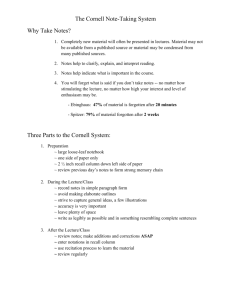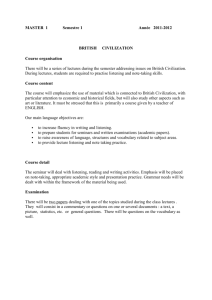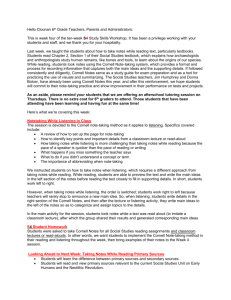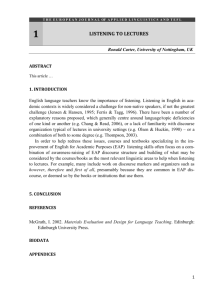Listening, Note-Taking, and Participating: Instructor's Manual
advertisement
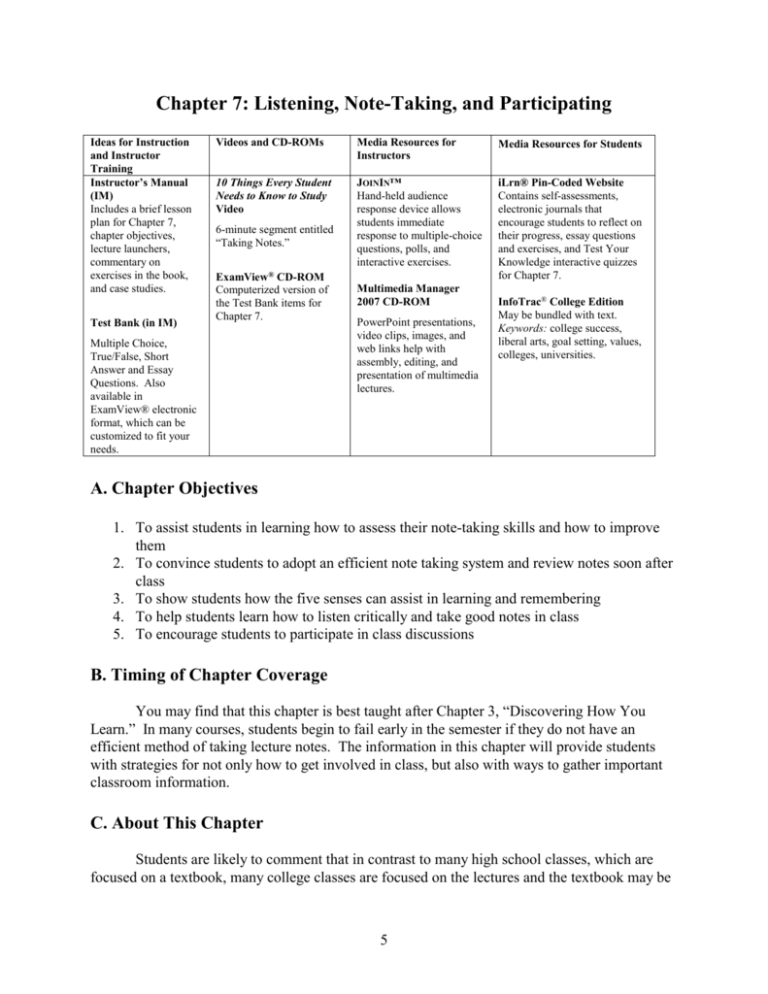
Chapter 7: Listening, Note-Taking, and Participating Ideas for Instruction and Instructor Training Instructor’s Manual (IM) Includes a brief lesson plan for Chapter 7, chapter objectives, lecture launchers, commentary on exercises in the book, and case studies. Test Bank (in IM) Videos and CD-ROMs Media Resources for Instructors Media Resources for Students 10 Things Every Student Needs to Know to Study Video JOININ™ Hand-held audience response device allows students immediate response to multiple-choice questions, polls, and interactive exercises. iLrn® Pin-Coded Website Contains self-assessments, electronic journals that encourage students to reflect on their progress, essay questions and exercises, and Test Your Knowledge interactive quizzes for Chapter 7. 6-minute segment entitled “Taking Notes.” ExamView® CD-ROM Computerized version of the Test Bank items for Chapter 7. Multiple Choice, True/False, Short Answer and Essay Questions. Also available in ExamView® electronic format, which can be customized to fit your needs. Multimedia Manager 2007 CD-ROM PowerPoint presentations, video clips, images, and web links help with assembly, editing, and presentation of multimedia lectures. InfoTrac® College Edition May be bundled with text. Keywords: college success, liberal arts, goal setting, values, colleges, universities. A. Chapter Objectives 1. To assist students in learning how to assess their note-taking skills and how to improve them 2. To convince students to adopt an efficient note taking system and review notes soon after class 3. To show students how the five senses can assist in learning and remembering 4. To help students learn how to listen critically and take good notes in class 5. To encourage students to participate in class discussions B. Timing of Chapter Coverage You may find that this chapter is best taught after Chapter 3, “Discovering How You Learn.” In many courses, students begin to fail early in the semester if they do not have an efficient method of taking lecture notes. The information in this chapter will provide students with strategies for not only how to get involved in class, but also with ways to gather important classroom information. C. About This Chapter Students are likely to comment that in contrast to many high school classes, which are focused on a textbook, many college classes are focused on the lectures and the textbook may be 5 supportive rather than primary. Because of this essential difference, college students must listen attentively to lectures and write down both main ideas and supporting details in ways that are clear, comprehensive, and conducive to learning and recall later on. If they do not listen and take effective notes, there may not be a textbook to fall back on like there was in high school. As a rule, testing is fairly frequent in high school. It is usually much less frequent in college. In fact, at some schools, instructors of first-year courses test only twice during the term and once during finals. Consequently, there are long periods of time between the delivery of the information and the demonstration of knowledge. This suggests, once again, the importance of accurate and effective note taking. After discussing these essential differences, you might want to shift the focus to the importance of having a note taking system. This is paramount to a student’s success in the classroom. With the chapter information and exercises, help them to identify a system that will complement their learning styles. The Cornell Method is a proven way for most students to take notes. However, allow them to be creative. This chapter gives specific strategies for before, during, and after class as well as class participation. Make sure students know these strategies and can determine how they will improve their classroom experience and overall learning. D. Suggested Outline for Addressing Topics in Chapter 7 STEP I: BEGIN WITH A LECTURE LAUNCHER OR ICEBREAKER ACTIVITY STEP II: EMPLOY A VARIETY OF CLASSROOM ACTIVITIES a. Use the PowerPoint presentation from Multimedia Manager 2007 resource b. Expand on key lesson themes c. Involve peer leaders d. Use chapter exercises e. Engage students in learning through case studies STEP III: REVIEW & PREVIEW a. Address common questions and concerns about the topic b. Writing reflection c. Prepare for next class Expanded Lesson Plan STEP I: Lecture Launchers and Icebreakers You may want to begin by asking students to discuss how college classes are structured different from high school classes and how they are adjusting to this transition. Examining these differences may help them to bridge the gaps they are experiencing as new students. Ask them to consider and discuss some of the following questions: o How are they adjusting to the transition in the classroom? o Are some college classes easier to take notes in? Why? 6 o What does the instructor do to facilitate students’ understanding of lectures? o What does the instructor do to make it easy to take notes? o What strategies can make note taking easier? Ask students to share any difficulties they are having with lectures with their partners. From there, you can discuss student experiences in the classroom with lectures, notetaking, and participation. This is a place to start as well as evaluate students’ skill levels. STEP II: Classroom Activities a. Use the PowerPoint presentations in Multimedia Manager 2007 resource to complement your mini lecture. b. Key Lesson Themes Testing Memory: 1. Ask your students to think back to a lecture they heard in another class the day before. 2. Have them jot down as many main ideas and supporting details as they can remember. 3. As part of a homework assignment or in class, have them compare these lists to the notes they took in that class. 4. Students quickly realize how incomplete their lists are. This activity demonstrates, more clearly than any lecture could, how important it is to review. Effective Note-Taking: 1. Ask your students to take notes on this lecture. Afterward, give them an additional 10 minutes to fill in the recall column. 2. Next, have students pair up to compare the most important ideas presented in the lecture. Have them discuss whether reading the assignment prior to the lecture informed their note taking abilities. 3. An alternative is to instruct your students not to take notes on the lecture. Then deliver another mini lecture of equal difficulty, but this time, instruct the students to take notes. During your next class meeting, quiz them on both lectures to demonstrate that their recall of the second lecture was greater. c. Group Activities Ask students to work in pairs and compare class notes for this course. Let them use the questions on page 117 --WORKING TOGETHER: Comparing Notes to explain their method of note taking and listen to others explain theirs. d. Peer Leader Assistance Ask students to take out the notebook they use for one of their more difficult classes. Pair 7 them up and have them show one page of their notes to their partner. Let each partner see if they can “make sense” of this page of notes. They can give feedback on the following: o Can they understand the general idea of the notes? o Can they identify the topic of the lecture? o How do the notes look to them? Show the students a sample of how you take notes and discuss with the students the strengths and weakness of your note taking style. e. Case Studies Nate Nate is a first-year student. He has had difficulty concentrating during the first week of lectures in his economics class and already seems to be losing his focus in his other classes. Listening to lectures and taking notes is extremely difficult for him. He’s finding that his notes do not make sense and he seems to be lacking important lecture information. At the end of the first week, he goes to his economics professor’s office hours. He then proceeds to tell the professor that when he was in elementary school he was diagnosed with Attention Deficit Hyperactivity Disorder (ADHF). He confides that he has been taking medication and getting some additional assistance from teachers with note taking and studying for tests, beginning in elementary school and right up through high school. Discussion Questions: 1. What suggestions would you make to help Nate? 2. What strategies do you have that might help Nate in other classes? 3. What ways can instructors adjust their teaching style to assist students like Nate? 4. What other ways could the instructor help Nate? Rita Rita has recently returned to college and started taking night classes. After high school, she started working full time in a law firm to make money, gain experience, and see if she would be interested in pursuing law school. She works full time during the day, and lives at home with her parents. Rita’s night classes are long and she is usually very tired from her workday when she gets there. All Rita can seem to do is sit back in her lectures and take notes. She feels too tired to ask questions and participate in class activities. She knows that class participation counts for 20% of her grade in one class. Rita knows she can pass the class with at least a C by doing this, but it is not her best effort. She is trying to get good grades now so when she applies to law school, she will have a competitive GPA. Rita wants to get “A”s in her classes. Discussion Questions: 1. What are Rita’s issues in this situation? 2. What strategies would you suggest Rita use in the classroom? 8 3. What strategies outside the classroom would you suggest for Rita? 4. How can Rita motivate herself to participate in class and in her learning? 5. How can Rita become a more active learner? f. Chapter Exercises Exercise 7.1: What System of Note-Taking Works for You? Give students a few minutes at the end of one of your lectures to do this exercise with a partner. (Or, you can use this as a Lecture Launcher). They will benefit from their partner’s feedback. Have them identify the changes they want to make. Exercise 7.2: Memory: Using a Recall Column Working with partners or writing their findings on this exercise will be effective practice for students. With partners, have them test each other using the recall column and then discuss the exercise questions. Encourage students to begin to formulate a note taking system if they don’t already have one. STEP III: Review and Preview REVIEW a. Address Common Questions and Concerns of First-Year Students: Why do I need to take notes? I can just read the text. Answer: Just reading the text is not enough to effectively learn class material. Many times instructors present lecture material that supplements the textbook. Students need to realize that they may miss important information if they do not take notes. Why do I have to take notes? I like to sit back and enjoy the lecture, and taking notes gets in the way. Answer: Effective learning takes place when students are actively engaged with the lecture material. Explain to them some of the differences between active and passive students in the classroom (if you have not yet covered Chapter 4, “Engagement with Learning”). Remind them that note taking enhances active listening, furthers their absorption of the material, and provides additional structure to test preparation. Why can’t I just bring in a tape recorder? Answer: While recording a lecture may be helpful in some ways, it may not be as effective as the student anticipates. Tell students that recording a lecture often insures that they will sit through it at least twice. This can be extremely time consuming. Encourage students to find other ways to get lecture information. However, if there’s a reason students need to tape the lecture, commuters for example, may want to take advantage of listening to the taped lectures during their commute – remind them to ask their instructor’s permission before doing so. 9 How can I take notes when he/she talks too fast? Answer: Students sometimes run into this problem. First, remind them that they do not have to write down everything a professor says. Encourage them to explore other methods of filling in their notes, such as meeting with the professor or forming a study group to compare notes. Should I take notes during a discussion? Answer: Discussions are a part of active learning. Encourage students to write down key points and discussions. They may need to correlate discussion notes with their lecture notes, as well as determine their importance to the class material. Remind students that they may be responsible for the information presented during a discussion session on a later test. If an outline is presented, should I copy it all down at the beginning of the lecture? Answer: Encourage students to copy an outline as it’s presented so they don’t miss important lecture information. b. Writing Reflection Give students a few minutes to answer the questions on page 118. PREVIEW FOR NEXT CLASS Assign a few pages from a magazine for the next class that include some of the following elements: pictures, illustrations, a chart, a graph, shorter and longer articles. Which articles and pieces of information did students remember the most? Which elements reinforce their memory? E. Test Questions Multiple Choice - choose ONE answer per question. 1. In virtually every college class you will need to master the following skills of in order to earn high grades: a. Note-taking, talking and participating b. Note-taking, writing and reading c. Note-taking, listening and participating d. None of the above 2. During lecture, you should focus LEAST on a. facts and figures. b. main concepts. c. central ideas. d. new information. 3. Which of the following is most important when it comes to effective note taking? 10 a. b. c. d. Taping the lecture Memorizing the recall column Identifying the main points Writing the information down verbatim 4. Listening in class is like a. listening to a TV program. b. listening to a friend. c. listening to a speaker at a meeting. d. none of the above 5. One method for organizing notes is called a. Cornell format. b. Jewler method. c. College success method. d. none of the above 6. Good participation involves all of the following EXCEPT a. mentioning a relevant book or past experience. b. sitting at the front of the room. c. keeping simple questions to yourself. d. bluffing through a question to keep the class conversation moving. True/False 7. During lecture, it is best to use shorthand and write down everything the teacher says verbatim. 8. During class discussion you don’t have to take notes as long as you participate. 9. You cannot assume that college instructors lecture on the same material covered in the course text. 10. Comparing notes with another student is a form of cheating. Short Answer 11. List some reasons why sharing notes can be a good practice. 12. List some reasons why sharing notes can be counterproductive. Essay 13. Describe three strategies you can use to listen critically during a lecture. Explain the benefits of using them and why they will work. 11 14. Draw a diagram of the Cornell method of note taking and list the parts. Then, discuss the benefits of using a note taking system. 1. Describe some of the things you can do prior to the start of a lecture to prepare for learning and remembering. 16. Give a brief description of the note taking formats that the text recommends. Discuss your personal preference. 17. Describe the steps to follow when taking notes. Which one(s) do you need to work on the most and why? CHAPTER 7 ANSWER KEY 1. c, p. 98 2. a, p. 102 3. c, p. 102 4. d, p. 101 5. a, p. 103 6. d, p. 110-111 7. false, p. 107 8. false, p. 107-108 9. true, p. 98 10. false, p. 99 F. Web Resources Why We Forget – http://sarc.sdes.ucf.edu/learningskills/WhyWeForgetTEXT.html The University of Central Florida hosts this web page, which lists seven common reasons for forgetting information, as well as suggestions to overcome each one. Cornell system - http://www.ucc.vt.edu/stdysk/cornell.html Note taking - http://www.dartmouth.edu/~acskills/success/notes.html This page also includes tips on recognizing important information, as well as additional note taking aids. Listening skills - http://www.infoplease.com/homework/listeningskills1.html Participating in Class – http://www.drlynnfriedman.com/classparticipation.html Clinical psychology Dr. Lynn Friedman offers her opinions as to why it’s important to participate in class discussion, as well as suggestions on how to prepare to participate. Applied Research – http://courseweb.gse.upenn.edu/~abrahaml/methods/appliedresearch.htm 12 A University of Pennsylvania master’s degree candidate conducted applied research on “How Can I Create a Space for Less Vocal Students to Participate in Science Class?” The above link takes you to the index for the site, which goes through the methodology behind the project, as well as the results. G. For More Information DePorter, Bobbi and Mike Hernacki. (2000). Quantum notes: Whole brain approaches to notetaking. Oceanside, CA: Learning Forum. Helgesen, Marc et al. (1995). Active listening: Introducing skills for understanding (student’s book 1). New York: Cambridge University Press. Kesselman-Turkel, Judi and Franklynn Peterson. (2003). Note-taking made easy. Madison, WI: University of Wisconsin Press. Stanley, Christine A. (2002). Engaging large classes: Strategies and techniques for college faculty. Bolton, MA: Anker Pub Co. Winter, Arthur and Ruth Winter. (1997). Brain workout: Easy ways to power up your memory, sensory perception, and intelligence. New York: St. Martin’s Press. 13
